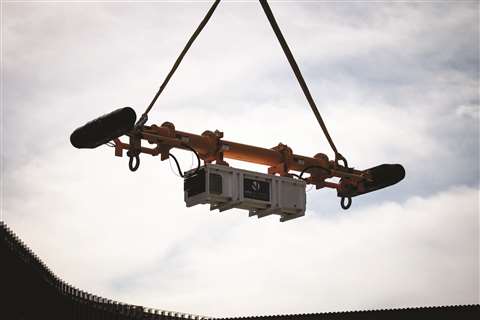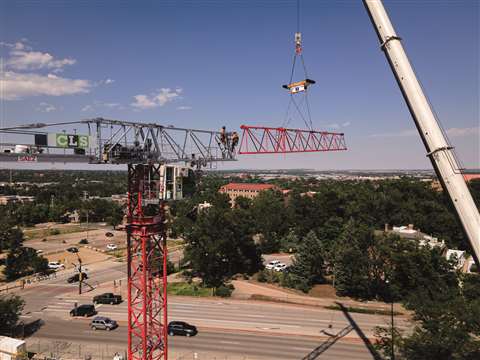Load control is vital for crane safety
10 May 2023
Crane rigging is crucial to construction and industrial projects, but can be among the most dangerous. According to the U.S. Bureau of Labor Statistics, hundreds of injuries and deaths involving cranes occur each year1. With such high stakes, it’s time to look closer at improving safety for crane rigging. One solution that has been gaining traction is load control.
 The Vita Load Navigator eliminates the need for a tagline on a load.
The Vita Load Navigator eliminates the need for a tagline on a load.
Load control refers to using various tools and techniques to ensure that a load being lifted by a crane remains stable and secure throughout the lifting process. This can include everything from specialized rigging equipment to computerized load monitoring systems. By stabilizing loads, the entire jobsite is safer and more efficient.
If you’re wondering why load control is so vital for crane safety, consider that:
Unstable loads can kill workers. One of the most apparent reasons to stabilize loads during crane rigging is that unstable loads are challenging to control with standard, manual solutions such as taglines. When a load shifts, spins or falls during lifting, crew members typically stand beneath the load holding the stabilizing tagline. Standing in harm’s way, they can be hit by the load or pulled from their location by holding on to the line. This is especially true when working with heavy loads or confined spaces with little room for error. Load control technology can move workers into safer places and eliminate unexpected shifts in the direction of the load.
 Load stabilization innovation needs to evolve beyond the tagline, which hasn’t changed for hundreds of years. Pictured is a tower crane being assembled using a Vita Load Navigator, which eliminates the tagline.
Load stabilization innovation needs to evolve beyond the tagline, which hasn’t changed for hundreds of years. Pictured is a tower crane being assembled using a Vita Load Navigator, which eliminates the tagline.
Real-time data improves operations. Using load control technology can give crane operators and project owners more insight into what’s working and not working. Data can track a load’s weight, stability and direction in real time, resulting in consistent adjustments and improvements to the operations. This can help identify potential problems before they become emergencies. It can also eliminate downtime, saving the company significant money caused by delays.
Reduce insurance costs. Insurance coverage is one of the highest costs of industrial construction projects, with premiums reaching more than $10 million or up to 15 percent of a project’s budget. Cranes pose a significant risk to pedestrians, cyclists, motorists and workers due to their size, weight and capacity to carry large, heavy objects. Crane accidents can cause fatal injuries leading to catastrophic financial losses for the companies involved. Because each construction project and environment are unique, unpredictability increases risk and insurance costs. With data that shows a reduction in worker’s comp claims, insurance companies can see an improvement in loss control and predictability, two items that can lower insurance premiums.
It’s time for load stabilization innovation to evolve beyond the tagline, which hasn’t changed for hundreds of years. Imagine other scenarios that now seem commonplace in construction:
■ Before telematics, insurance companies relied on motor vehicle records and credit scores of drivers to guess what type of drivers they were. This data was used to set insurance rates.
■ Hard hats are so valuable that many U.S. states reduce workers comp payouts by up to 15 percent if workers weren’t wearing a hard hat when injured.
■ With an average of 10 construction site fires per day nationally, it’s hard to imagine a site without a sprinkler system. They have become a best practice to avoid catastrophic loss.
The Vita Load Navigator (VLN) is a load control device that significantly increases safety and efficiency. The propulsion-driven device connects below the hook and can be autonomously and manually controlled. Measuring more than 1,000 data points per second, the system detects load movement in real-time and adjusts the load with high-powered fans to eliminate spinning, rotations, swaying or other problems that cause site damage or injuries. Loads are stabilized wirelessly by an operator from the ground. The worker holding the tagline is no longer under the heavy load, greatly enhancing his or her safety.
“Using the Vita Load Navigator meant we did not have to have riggers run through an obstacle course, making it much more efficient and safer for the crew,” said Josiah Rausch, crane tech manager for Creative Lifting Services.
Real-time data is collected and can be utilized to improve operations and costs. Lifting tasks can be stored in the device’s memory for easy recall and repeatability. Data from the use of the VLN has shown an improvement in operations, including 75 percent elimination of construction crane injuries, 63 percent overall crane accident reduction and up to a 50 percent increase in crane productivity.

Jeff Donaldson is chief marketing officer for Vita Inclinata Technologies.




